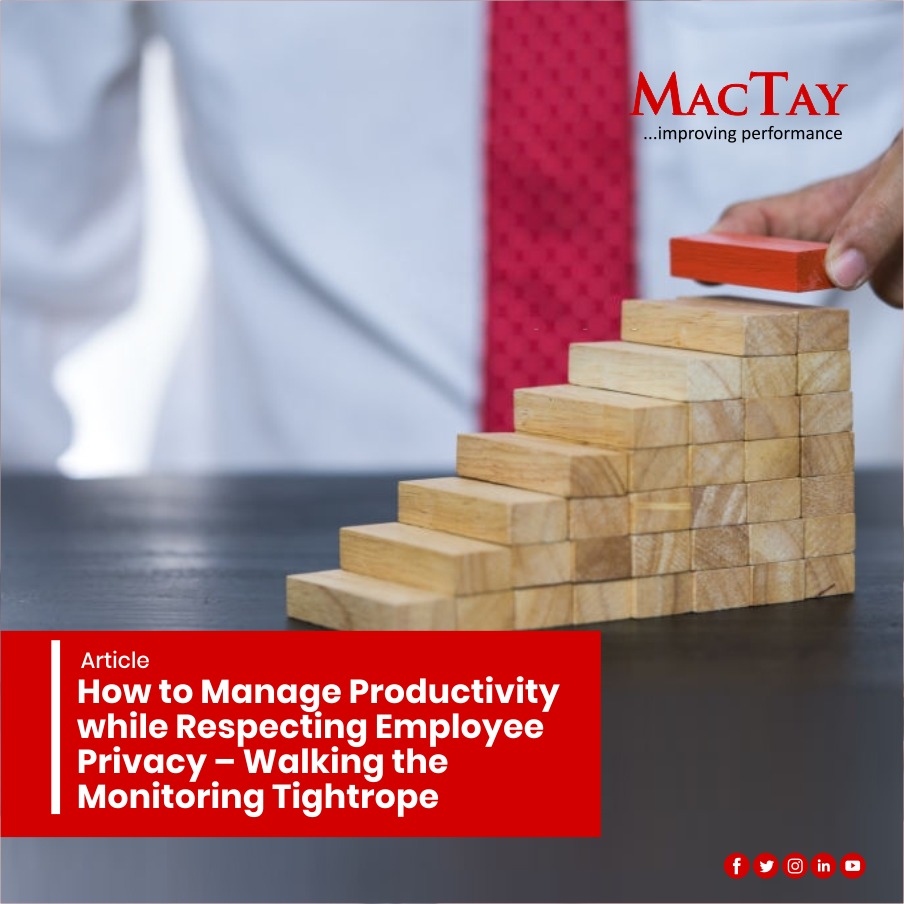
How to Manage Productivity while Respecting Employee Privacy – Walking the Monitoring Tightrope
COVID-19 pandemic has made a significant number of employees embrace the “work from home” option. Employers, however, still have to ensure that these employees are productive even while working remotely. The new challenge that may continue is how to optimise the productivity of the remote workforce. Gartner report (2018) revealed that as employers continue to explore new tools for understanding their workforce, employees are becoming more comfortable with being monitored, especially if they understand how and why. Therefore, the question to answer becomes “How do we monitor productivity without compromising the privacy of the employees?”
A research conducted by Accenture in 2019 opined that Business leaders would need to implement responsible workforce data strategies to build employee trust to generate sustained revenue growth. More than six in 10 C-level executives (62 percent) said their organisations use new technologies to collect data on their people and work to gain more actionable insights from the quality of work and the way people collaborate to their safety and well-being, while fewer than one-third (30 percent) are very confident that they use the data responsibly. From the research, 92 percent of workers are open to the collection of data on them and their work, but only if it improves their performance or well-being or provides other personal benefits. More than six in 10 workers (62 percent) are willing to exchange their work-related data for more customised compensation, rewards, and benefits, and 61 percent would do so for more customised learning and development opportunities.
Despite the availability of options, monitoring comes with real risk to the companies that pursue it. It threatens to erode trust between employers and employees. Employees who are subject to surveillance by the constant monitoring would be afraid to speak up, a recipe for not only dissatisfaction but also burnout, both of which could decrease productivity. Monitoring can invite a backlash. On the other hand, it is enticing to the business owners to engage in monitoring to protect productivity, however, in reality, it stands in stark contrast to recent trends in the corporate world. A new world order being embraced by many organisations is to foster a better employee experience, with particular focus on diversity, inclusion, and allowing the employee to exercise their free will and control over how work is done.
The Deloitte Global Millennial Survey (2019) found that 55% of millennials plan to leave employers that prioritise profits over people. Retention, which should be a priority for all companies, given the high cost of recruiting and onboarding new hires, becomes a challenge for companies that do not prioritise its people. Therefore, given the risk of alienating employees coupled with the possibility of error and misapplication of the monitoring tools, it is quite likely that, for many, the juice just is not worth the squeeze.
Some organisations will justify that the clear and present danger of dwindling bottom-line reasonably requires them to monitor their employees to ensure they are being productive and efficient. It is important to do so in a way that maximally respects their employees. Employees surveillance is a tightrope, to do or not to do, analysed below are the suggested ways to walk the tightrope:
- Choose your parameters carefully by involving all relevant stakeholders. If you want the right parameters, then engage all of the relevant stakeholders in the process to determine those parameters, from hiring managers to supervisors to those who are to be monitored.
- Be transparent with your employees about what you are monitoring and why. Communication with the employees should be open, what is being monitored, and why it is being monitored must be clearly stated.
- Accept that performance under this circumstance may not reflect employees’ best ability. These are unique times and it would be wrong ethically and truthfully to make decisions about the performance quality and diligence of employees under these conditions.
- Ensure that people in minority and other vulnerable groups are not disproportionately affected by the surveillance. Central to any company’s diversity and inclusion effort is a commitment to eliminating any discrimination against a traditionally marginalised population. These categories of people tend to occupy more junior roles in an organisation and junior roles often suffer the most scrutiny.
References
- How to Monitor your Employees – while respecting their Privacy
- Reid Blackman P.HD (Harvard Business Review)
- The future of Employee Monitoring
- Brian Kropp (Gartner Oversees Research 2019)
- More Responsible use of Workforce Data Required to Strengthen Employees Trust and unlock Growth
- Accenture Report
The Deloitte Global Millennial Survey 2019










